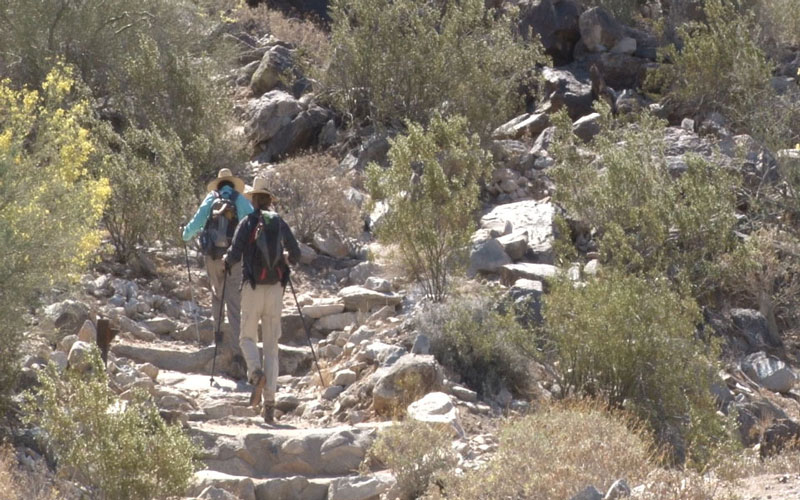
A couple hikes Telegraph Pass in South Mountain Park and Preserve. (Photo by Elena Mendoza/Cronkite News)
South Mountain Park and Preserve glistens like a desert gem nestled in Phoenix.
The preserve, about five miles from downtown, is one of the nation’s largest city-owned parks and provides more than 16,000 acres to escape from the hustle and bustle of the city.
“This is one of the best draws about this park is that when you come out, you do a hike…within minutes you feel like you’re miles away from the city,” said Dan Gronseth, who has been a park ranger for more than 27 years. “You’re never more than a mile away from the city at any point in the park, but you feel like you’re in the middle of the desert.”
Suzanne Schleck, a frequent hiker and winter visitor to the Phoenix area who was hiking in South Mountain for the first time, loved the experience and the convenience.
“Usually you have to drive hours to see something like this,” Schleck said. “It’s just incredible to be that close to so many beautiful natural areas.”
Besides scenic views, Gronseth said what sets the park apart is its rich history that dates back to when the Hohokam, an ancient Native American culture, called it home.
Preserving and building South Mountain
During the 1920s, Phoenix residents petitioned the federal government to make South Mountain a national park in an effort to protect the land.
“We have thousands and thousands of petroglyphs, which is probably the main reason why they wanted to preserve the park in the first place,” Gronseth said.
The director of the national park system at the time, Steven Mather, toured the park and said it wasn’t national park material but it should be preserved.
Gronseth said Mather suggested residents instead petition the government to purchase the land through the city.
The city bought 14,000 acres for $20,000.
“To give you an idea of what that is, it was a $1.25 per acre,” Gronseth said. “We are now purchasing land in the north for roughly $20,000 an acre.”
Then came the Great Depression.
The Civilian Conservation Corps, a work program in President Franklin D. Roosevelt’s New Deal program to create jobs for young men, sent out 200 workers in the 1930s to develop the land.
Gronseth said the park wouldn’t have a majority of the buildings, roads, trails and picnic areas you can see today had it not been for the conservation corps.
Mining for copper and gold
The park began to draw visitors to its large non-fuel mineral reserves and valuable gold mines.
“Even though they got more copper than anything else, out of our mines in South Mountain, they called them ‘gold mines’ because the value of the gold they got out was higher than the value of the copper they got out,” Gronseth said.
It was a lifestyle for some, including the manager who lived on-site and the mine workers who lived in mess tents.
One major mine even tunneled low enough to pump out groundwater.
Mining came to a halt in the early 1940s when the steel and other machinery was taken away to be used for war efforts.
Gronseth said it’s possible to make the mines operable again, but city officials won’t allow it.
Turning mountains into recreational treasure
For years South Mountain park has served as a free getaway for tourists and Phoenix area residents.
“I would love to spend a whole day just exploring the place,” said Keith Lotan, a hiker making his first trip to South Mountain. “It’s so accessible and close to the city.”
With more than 50 miles of trails, biking and hiking are the most popular things to do.
Gronseth said people also come out to picnic at the ramadas, hang-glide over the mountains, ride horses on the trails and to explore the various plants and animals.
The park also features a one-mile wheelchair accessible trail.
“That experience of being out here in the middle of nowhere is not only for the able bodied,” Gronseth said.
The city has been expanding the park little by little over the years.
“It’s almost all developed around, with the exception of the west…but it eventually will become developed all the way around,” he said.
For more information about trails, activities and other information at South Mountain park, go to https://www.phoenix.gov/parks